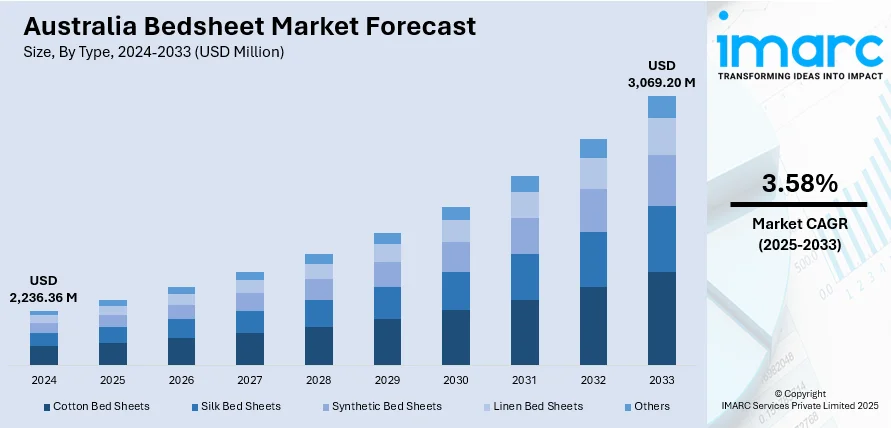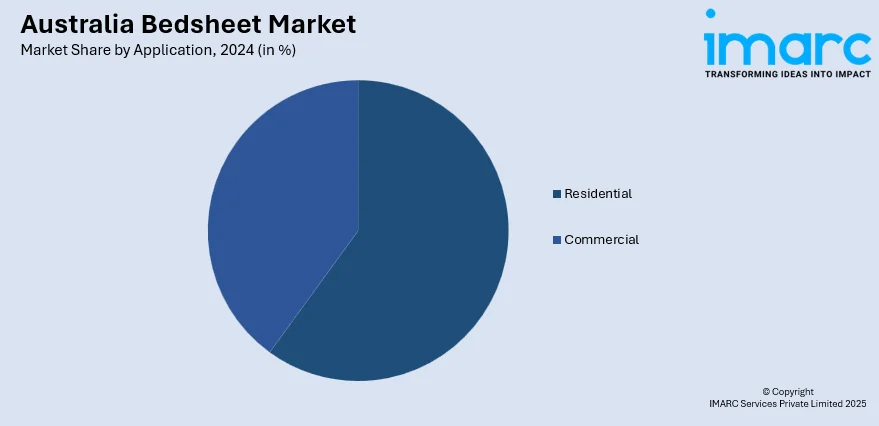
Australia Bedsheet Market Size, Share, Trends and Forecast by Type, Application, Sales Channel, and Region, 2025-2033
Australia Bedsheet Market Size and Share:
The Australia bedsheet market size reached USD 2,236.36 Million in 2024. Looking forward, IMARC Group expects the market to reach USD 3,069.20 Million by 2033, exhibiting a growth rate (CAGR) of 3.58% during 2025-2033. The market is also fueled by the growing consumer demand for sustainable and environmentally friendly products as consumers look for bedding products made of organic and recycled materials. Furthermore, continuous advances in technology like temperature-control and intelligent bedsheets appeal to the trend of customized sleep experiences. Furthermore, the trend of minimalist home furniture with fewer colors and simple designs is impacting consumer choices thereby boosting the Australia bedsheet market share.
|
Report Attribute
|
Key Statistics
|
|---|---|
|
Base Year
|
2024 |
|
Forecast Years
|
2025-2033
|
|
Historical Years
|
2019-2024
|
| Market Size in 2024 | USD 2,236.36 Million |
| Market Forecast in 2033 | USD 3,069.20 Million |
| Market Growth Rate 2025-2033 | 3.58% |
Key Trends of Australia Bedsheet Market:
Sustainability and Eco-Friendly Materials
In recent years, sustainability has become a major focus in the Australia bedsheet market growth. As consumers become more environmentally conscious, there is a rising demand for bedding made from eco-friendly materials such as organic cotton, bamboo, and recycled fabrics. This shift is driven by an increasing awareness of the environmental impact of manufacturing processes and a desire to reduce waste. In response, brands are adopting sustainable production practices, including using natural dyes, minimizing water usage, and ensuring ethical sourcing of materials. Consumers are also prioritizing products that are biodegradable or recyclable, further contributing to the demand for sustainable bedding options. As this trend grows, manufacturers are investing in more sustainable innovations, which not only appeal to eco-conscious buyers but also align with the broader movement towards environmentally responsible consumption in the home goods industry.

To get more information on this market, Request Sample
Minimalist Design and Neutral Tones
Within Australia's bedding market, there is a robust trend toward minimalist designs and neutral colors that represent consumers' need for serene, uncluttered environments. Clean looks such as whites, greys, beiges, and pastels are sought after for their ease of coordination and classic appeal, which harmonizes with more general interior trends that value simplicity and coziness. According to the Australia bedsheet market analysis, this trend toward minimalism also aligns with increased environmental consciousness. In June 2024, the Australian Government introduced the Seamless scheme, a circular clothing program designed to cut the 200,000+ tonnes of clothing that goes into landfill annually. Encouraging sustainable production and consumption, the scheme indirectly incentivizes demand for minimalist and eco-friendly bedding. As lines become clean, textures become soft, and materials low-impact, bedsheets are turning into products that exude not just aesthetic elegance but also ecological awareness in Australian households today.
Integration of Smart Technologies
The emergence of intelligent technologies has started to define the Australia bedsheet industry, mirroring the increasing demand for innovative home solutions that provide enhanced comfort and convenience. Customers are increasingly looking for bedding with innovative features, including temperature-control materials, moisture-wicking properties, and sleep monitors. These intelligent bedsheets enable the creation of an ideal sleeping environment, providing better sleep quality by responding to personal requirements. For instance, temperature-sensitive material adapts to the body temperature, while moisture-wicking fabrics ensure users stay dry during the night. Such technological advancements respond to increased demand for customized, data-driven sleep experiences. As the market continues to grow, future developments in bedding promise more high-tech aspects to enhance sleep wellness and general well-being, making smart bedsheets a desirable choice for tech-conscious consumers who want the latest comfort.
Growth Factors of Australia Bedsheet Market:
Rising Demand for Sustainable and Organic Bedding Materials
Australian consumers are increasingly eco-conscious, fueling demand for bedsheets made from sustainable and organic materials such as bamboo, organic cotton, hemp, and TENCEL. These materials are favored not only for their lower environmental impact but also for their hypoallergenic and breathable qualities, making them ideal for health-conscious and environmentally aware buyers. For products that reflect their beliefs, such as biodegradable packaging, reduced water usage, and ethical sourcing, consumers are willing to pay more. Brands that emphasize transparent supply chains, eco-certifications (like GOTS or OEKO-TEX), and green manufacturing practices are gaining traction. This trend is expected to intensify as environmental awareness grows and sustainability becomes a central purchasing criterion, especially among millennials and Gen Z consumers.
Innovation in Fabric Technology and Functional Features
Technological advancements in fabric development have significantly enhanced the functionality and appeal of modern bedsheets in Australia. Consumers are no longer interested in products that focus solely on the aesthetic benefits of sleep products like sheets, pillowcases, etc. These aspects are particularly applicable to the varying climate regions of Australia, whereby thermo comfort is of prime consideration. Brands are spending on natural-synthetic fiber combinations or undertaking intelligent textile finishes to design high-performance and easy-care bedding. This expanding market of so-called functional luxury serves the needs of busy professionals, families, and people with special health or skin sensitivity needs. The added convenience and performance benefits of these technologically advanced bedsheets are a major factor escalating the Australia bedsheet market demand.
Growth of E-Commerce and Direct-to-Consumer Brands
The growth of online retail and direct-to-consumer (DTC) models has significantly expanded the accessibility and visibility of bedsheet brands in Australia. E-commerce platforms allow consumers to compare materials, read reviews, and access custom or niche products that may not be available in brick-and-mortar stores. Many new-age bedding startups use social media and influencer marketing to build brand trust and educate consumers about thread counts, fabric benefits, and sustainable choices. Subscription models and bundle deals are also driving repeat purchases and customer retention. Furthermore, online customization options, like size, fabric type, and color, cater to diverse preferences. The convenience, competitive pricing, and expansive selection offered by digital retail are helping fuel sustained growth in the market.
Australia Bedsheet Market Segmentation:
IMARC Group provides an analysis of the key trends in each segment of the market, along with forecasts at the country and regional levels for 2025-2033. Our report has categorized the market based on type, application, and sales channel.
Type Insights:
- Cotton Bed Sheets
- Silk Bed Sheets
- Synthetic Bed Sheets
- Linen Bed Sheets
- Others
The report has provided a detailed breakup and analysis of the market based on the type. This includes cotton bed sheets, silk bed sheets, synthetic bed sheets, linen bed sheets, and others.
Application Insights:

- Residential
- Commercial
A detailed breakup and analysis of the market based on the application have also been provided in the report. This includes residential and commercial.
Sales Channel Insights:
- Supermarket and Hypermarket
- Specialty Store
- Online
The report has provided a detailed breakup and analysis of the market based on the sales channel. This includes supermarket and hypermarket, specialty store, and online.
Regional Insights:
- Australia Capital Territory & New South Wales
- Victoria & Tasmania
- Queensland
- Northern Territory & Southern Australia
- Western Australia
The report has also provided a comprehensive analysis of all the major regional markets, which include Australia Capital Territory & New South Wales, Victoria & Tasmania, Queensland, Northern Territory & Southern Australia, and Western Australia.
Competitive Landscape:
The market research report has also provided a comprehensive analysis of the competitive landscape. Competitive analysis such as market structure, key player positioning, top winning strategies, competitive dashboard, and company evaluation quadrant has been covered in the report. Also, detailed profiles of all major companies have been provided.
Australia Bedsheet Market News:
- In June 2024, BEDGEAR® opened its first flagship store in Australia at Warringah Mall, Sydney, marking its expansion into the Australian market. The 120-square-metre store offers an interactive experience, allowing customers to be personally fitted for personalized sleep systems, including mattresses, pillows, and lifestyle products. BEDGEAR’s innovative sleep solutions are tailored to individual preferences, with a focus on comfort and technology. The store will also showcase upcoming products, like BEDGEAR Baby.
- In April 2024, Hommey launched its softest bedding collection yet, made from organic cotton and available in 12 colorways. The new collection promises ultimate comfort, ideal for cozying up this winter. Known for its popular robes, Hommey expands its product range with this luxurious bedding line, offering a blend of sustainability and comfort. The bedding collection is designed to enhance your bedroom experience with its high-quality, soft feel and eco-friendly materials.
Australia Bedsheet Market Report Coverage:
| Report Features | Details |
|---|---|
| Base Year of the Analysis | 2024 |
| Historical Period | 2019-2024 |
| Forecast Period | 2025-2033 |
| Units | Million USD |
| Scope of the Report |
Exploration of Historical Trends and Market Outlook, Industry Catalysts and Challenges, Segment-Wise Historical and Future Market Assessment:
|
| Types Covered | Cotton Bed Sheets, Silk Bed Sheets, Synthetic Bed Sheets, Linen Bed Sheets, Others |
| Applications Covered | Residential, Commercial |
| Sales Channels Covered | Supermarket and Hypermarket, Specialty Store, Online |
| Regions Covered | Australia Capital Territory & New South Wales, Victoria & Tasmania, Queensland, Northern Territory & Southern Australia, Western Australia |
| Customization Scope | 10% Free Customization |
| Post-Sale Analyst Support | 10-12 Weeks |
| Delivery Format | PDF and Excel through Email (We can also provide the editable version of the report in PPT/Word format on special request) |
Key Benefits for Stakeholders:
- IMARC’s industry report offers a comprehensive quantitative analysis of various market segments, historical and current market trends, market forecasts, and dynamics of the Australia bedsheet market from 2019-2033.
- The research report provides the latest information on the market drivers, challenges, and opportunities in the Australia bedsheet market.
- Porter's five forces analysis assist stakeholders in assessing the impact of new entrants, competitive rivalry, supplier power, buyer power, and the threat of substitution. It helps stakeholders to analyze the level of competition within the Australia bedsheet industry and its attractiveness.
- Competitive landscape allows stakeholders to understand their competitive environment and provides an insight into the current positions of key players in the market.
Key Questions Answered in This Report
The bedsheet market in Australia was valued at USD 2,236.36 Million in 2024.
The Australia bedsheet market is projected to reach a value of USD 3,069.20 Million by 2033.
The Australia bedsheet market is projected to exhibit a CAGR of 3.58% during 2025-2033.
Australia’s bedsheet market is evolving with a strong shift toward sustainable, eco-friendly materials (bamboo, organic cotton, recycled fibers), advanced functional fabrics featuring temperature regulation and antimicrobial finishes, and a minimalist design aesthetic favoring neutral tones. Additionally, e-commerce growth is boosting accessibility and online sales.
Key growth drivers of Australia’s bedsheet market include rising consumer demand for environment-friendly fabrics like bamboo and organic cotton, technological innovations such as temperature-regulating and antimicrobial fabrics, and rapid expansion of e-commerce channels that enhance accessibility and personalization.
Need more help?
- Speak to our experienced analysts for insights on the current market scenarios.
- Include additional segments and countries to customize the report as per your requirement.
- Gain an unparalleled competitive advantage in your domain by understanding how to utilize the report and positively impacting your operations and revenue.
- For further assistance, please connect with our analysts.
 Request Customization
Request Customization
 Speak to an Analyst
Speak to an Analyst
 Request Brochure
Request Brochure
 Inquire Before Buying
Inquire Before Buying




.webp)




.webp)












